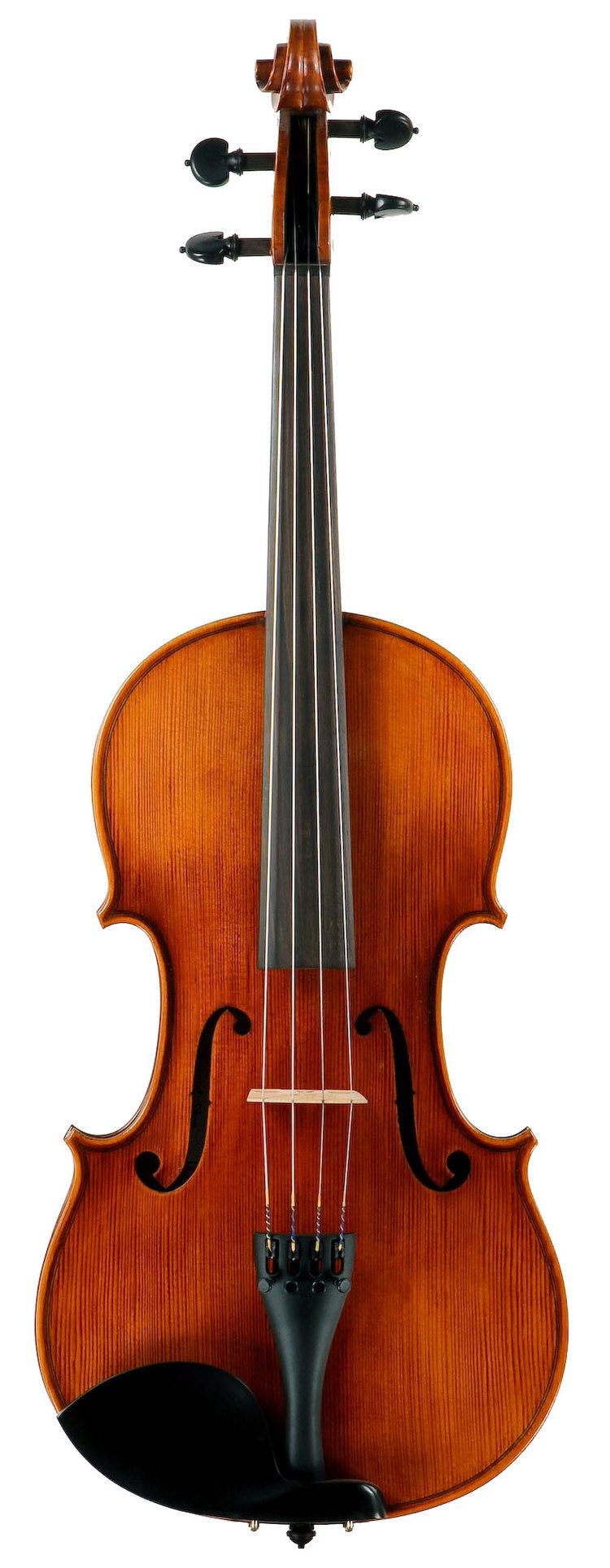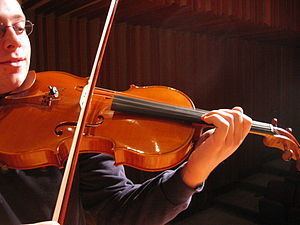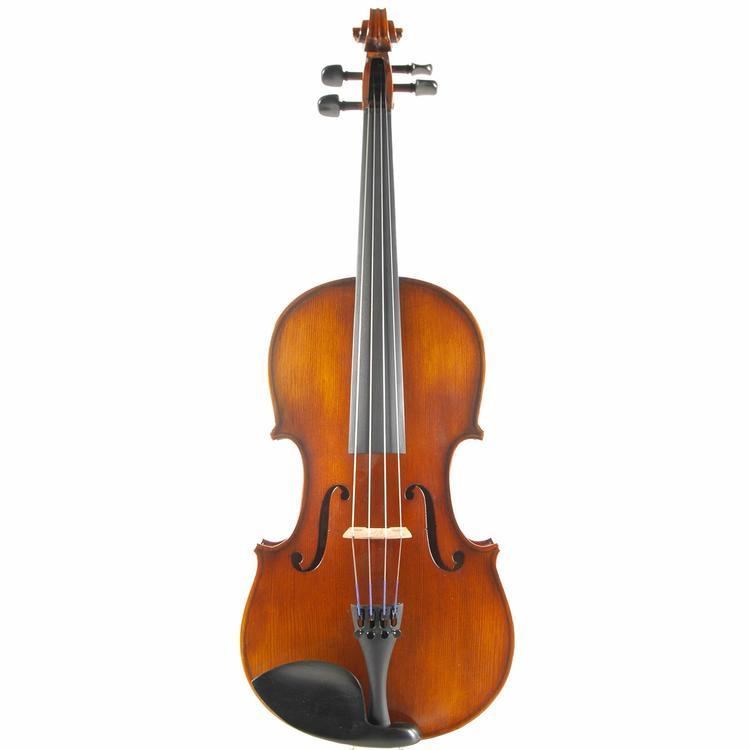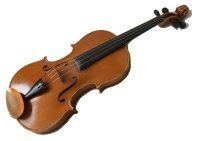Place of origin Western Europe | ||
 | ||
Other names French: alto; German: Bratsche Hornbostel–Sachs classification 321.322-71; (Composite chordophone sounded by a bow) | ||
Instrument viola
The viola (/viˈoʊlə/; [ˈvjɔːla]) is a string instrument that is bowed or played with varying techniques. It is slightly larger than a violin and has a lower and deeper sound. Since the 18th century it has been the middle or alto voice of the violin family, between the violin (which is tuned a perfect fifth above) and the cello (which is tuned an octave below).The strings from low to high are generally tuned to C3, G3, D4, and A4.
Contents
- Instrument viola
- Pharrell williams happy jeremy green viola cover
- Form
- Method of playing
- Tuning
- Organizations and research
- Reading music
- Role in pre twentieth century works
- Twentieth century and beyond
- Contemporary pop music
- Pop music featuring the viola
- In folk music
- Performers
- In popular culture
- Electric violas
- References

In the past, the viola varied in size and style as did its names. The Italians often used the term: "viola da braccio" meaning literally: 'of the arm'. "Brazzo" was another Italian word referring to the viola which the Germans adopted in the form: "Bratsche". The French had their own names: "Cinquiesme" was a small viola,"Haute Contre" was a large viola and "Taile" meant "Tenor". In the modern era, the French use the term "Alto", a reference to its range.

The viola had enjoyed popularity in the heyday of five-part harmony up until the eighteenth century, taking three lines of the harmony and occasionally playing the melody line. Music that is written for the viola differs from that of most other instruments in that it primarily uses the alto clef. Viola music switches to the treble clef when there are substantial sections of music written in a higher register to make the notes easier to read.
The viola often plays the "inner voices" in string quartets and symphonic writing, and it is more likely than the first violin to play accompaniment parts. The viola occasionally plays a major, soloistic role in orchestral music. Examples include Don Quixote by Richard Strauss and Harold en Italie by Hector Berlioz. In the earlier part of the 20th century, more composers began to write for the viola, encouraged by the emergence of specialized soloists such as Lionel Tertis and William Primrose. English composers Arthur Bliss, York Bowen, Benjamin Dale, Frank Bridge, Benjamin Britten and Ralph Vaughan Williams all wrote substantial chamber and concert works. Many of these pieces were commissioned by, or written for Lionel Tertis. William Walton, Bohuslav Martinů, Toru Takemitsu, Tibor Serly, Alfred Schnittke, and Béla Bartók have written well-known viola concertos. Paul Hindemith wrote a substantial amount of music for viola, including the concerto Der Schwanendreher. The concerti by Paul Hindemith, Béla Bartók, and William Walton are the "big three" of viola repertoire.

Pharrell williams happy jeremy green viola cover
Form

The viola is similar in material and construction to the violin. A full-size viola's body is between 25 mm (1 in) and 100 mm (4 in) longer than the body of a full-size violin (i.e., between 38 and 46 cm [15–18 in]), with an average length of 41 cm (16 in). Small violas typically made for children typically start at 30 cm (12 in), which is equivalent to a half-size violin. For a child who needs a smaller size, a fractional-sized violin is often strung with the strings of a viola. Unlike the violin, the viola does not have a standard full size. The body of a viola would need to measure about 51 cm (20 in) long to match the acoustics of a violin, making it impractical to play in the same manner as the violin. For centuries, viola makers have experimented with the size and shape of the viola, often adjusting the proportions or shape to make a lighter instrument with shorter string lengths, but which still has a large enough sound box to create an unmistakable "viola sound". Prior to the eighteenth century, violas had no uniform size, the large violas (tenors) were designed to play the lower register viola lines or second viola in five part harmony depending on the instrumentation. Smaller violas nearer to the size of the violin were referred to as "alto violas" and were more suited to the higher register writing as in the viola 1 parts, as their sound was usually richer in the upper register, its size not being as conducive to a full tone in the lower register.

There have been several experiments intended to increase the size of the viola, in the interest of improving the instrument's sound. Hermann Ritter's viola alta, which measured about 48 cm (19 in), was intended for use in Wagner's operas. The Tertis model viola, which has wider bouts and deeper ribs to promote a better tone, is another slightly "nonstandard" shape that allows the player to use a larger instrument. Many experiments with the acoustics of a viola, particularly increasing the size of the body, have resulted in a much deeper tone, making it resemble the tone of a cello. Since many composers wrote for a traditional-sized viola, particularly in orchestral music, changes in the tone of a viola can have unintended consequences upon the balance in ensembles.

One of the most notable makers of violas of the twentieth century was Englishman A. E. Smith, whose violas are sought after and highly valued. Many of his violas remain in Australia, his country of residence, where during some decades the violists of the Sydney Symphony Orchestra had a dozen of them in their section.
More recent (and more radically shaped) innovations have addressed the ergonomic problems associated with playing the viola by making it shorter and lighter, while finding ways to keep the traditional sound. These include the Otto Erdesz "cutaway" viola, which has one shoulder cut out to make shifting easier; the "Oak Leaf" viola, which has two extra bouts; viol-shaped violas such as Joseph Curtin's "Evia" model, which also utilizes a moveable neck and a maple-veneered carbon fibre back, to reduce weight: violas played in the same manner as cellos (see vertical viola); and the eye-catching "Dalí-esque" shapes of both Bernard Sabatier's violas in fractional sizes—which appear to have melted—and David Rivinus' Pellegrina model violas.
Other experiments that deal with the "ergonomics vs. sound" problem have appeared. The American composer Harry Partch fitted a viola with a cello neck to allow the use of his 43-tone scale. Luthiers have also created five-stringed violas, which allow a greater playing range.
Method of playing
A person who plays the viola is called a violist or a viola player. The technique required for playing a viola has certain differences compared with that of a violin, partly because of its larger size: the notes are spread out farther along the fingerboard and often require different fingerings. The viola's less responsive strings and the heavier bow warrant a somewhat different bowing technique, and a violist has to lean more intensely on the strings.
Tuning
The viola's four strings are normally tuned in fifths: the lowest string is C (an octave below middle C), with G, D and A above it. This tuning is exactly one fifth below the violin, so that they have three strings in common—G, D, and A—and is one octave above the cello.
Each string of a viola is wrapped around a peg near the scroll and is tuned by turning the peg. Tightening the string raises the pitch; loosening the string lowers the pitch. The A string is normally tuned first, typically to a pitch of 440 Hz or 442 Hz. The other strings are then tuned to it in intervals of perfect fifths, sometimes by bowing two strings simultaneously. Most violas also have adjusters, also called "fine tuners", that are used to make finer changes. These permit the tension of the string to be adjusted by rotating a small knob at the opposite or tailpiece end of the string. Such tuning is generally easier to learn than using the pegs, and adjusters are usually recommended for younger players and put on smaller violas, although pegs and adjusters are usually used in conjunction with one another. Adjusters work best, and are most useful, on metal strings. It is common to use one on the A string, even if the others are not equipped with them. Some violists reverse the stringing of the C and G pegs, so that the thicker C string does not turn so severe an angle over the nut, although this is uncommon.
Small, temporary tuning adjustments can also be made by stretching a string with the hand. A string may be tuned down by pulling it above the fingerboard, or tuned up by pressing the part of the string in the pegbox. These techniques may be useful in performance, reducing the ill effects of an out-of-tune string until an opportunity to tune properly.
The tuning C–G–D–A is used for the great majority of all viola music. However, other tunings are occasionally employed, both in classical music, where the technique is known as scordatura, and in some folk styles. Mozart, in his Sinfonia Concertante for Violin, Viola and Orchestra in E♭, wrote the viola part in D major and specified that the viola's strings were to be raised in pitch by a semitone: his intention was probably to give the viola a brighter tone so as to avoid it being overpowered by the rest of the ensemble. Lionel Tertis, in his transcription of the Elgar cello concerto, wrote the slow movement with the C string tuned down to B♭, enabling the viola to play one passage an octave lower. Occasionally the C string may also be tuned up to D.
Organizations and research
A renewal of interest in the viola by performers and composers in the twentieth century has led to increased research devoted to the instrument. Paul Hindemith and Vadim Borisovsky made an early attempt at an organization in 1927 with the Violists' World Union. But it was not until 1968, with the creation of the Viola-Forschungsgellschaft, now the International Viola Society (IVS), that a lasting organization would take hold. The IVS now consists of twelve sections around the world, the largest being the American Viola Society (AVS), which publishes the Journal of the American Viola Society. In addition to the journal, the AVS sponsors the David Dalton Research Competition and the Primrose International Viola Competition.
The 1960s also saw the beginning of several research publications devoted to the viola, beginning with Franz Zeyringer's Literatur für Viola, which has undergone several versions, the most recent being in 1985. In 1980, Maurice Riley produced the first attempt at a comprehensive history of the viola in his History of the Viola, which was followed with a second volume in 1991. The IVS published the multi-language Viola Yearbook (from 1979 to 1994): several other national sections of the IVS publish newsletters. The Primrose International Viola Archive at Brigham Young University houses the greatest amount of material that is related to the viola, including scores, recordings, instruments and archival materials from some of the world's greatest violists.
Reading music
Music that is written for the viola differs from that of most other instruments, in that it primarily uses the alto clef, which is otherwise rarely used. The trombone occasionally uses the alto clef, but not primarily. (The comparatively rare alto trombone primarily uses the alto clef.) Viola music employs the treble clef when there are substantial sections of music written in a higher register. In the alto clef, the note A4 is the space above the top line of the clef, D4 is in the second space down, G3 is in the space at the bottom of the staff, and C3 is two spaces under the staff. In treble clef, the note A4 is the second space, D4 is one space under the staff, and so on.
As the viola is tuned exactly one octave above the cello (meaning that the viola retains the same string notes as the cello, but an octave up), pieces written for the cello can be easily transposed to the viola clef. For example, there are numerous editions of Bach's Cello Suites transcribed for viola that retain the original key, notes, and musical patterns. The viola also has the advantage of smaller strings, which means that the intervals meant for cello are easier to play on the viola.
Role in pre-twentieth century works
In early orchestral music, the viola part was frequently limited to filling in harmonies and little melodic material was assigned to it. If the viola was given a melodic part, it was often duplicated (or was in unison with) the melody played by other strings.
The concerti grossi: "Brandenburg Concerti" composed by J. S. Bach were unusual in their use of viola. The third concerto grosso, scored for three violins, three violas and lower strings with basso continuo requires occasional virtuosity from the violists, the sixth concerto grosso: Brandenburg Concerto No. 6 scored for 2 violas "concertino", cello, 2 violas da gamba, and continuo, in which the two violas were placed in the primary melodic role. He also used this unusual ensemble in his cantata, Gleichwie der Regen und Schnee vom Himmel fällt, BWV 18 and in Mein Herze schwimmt im Blut, BWV 199, the chorale is accompanied by an obbligato viola.
There are a few Baroque and Classical concerti, such as those by Georg Philipp Telemann (one of the earliest viola concertos known), Franz Anton Hoffmeister and Carl Stamitz. Hector Berlioz's Harold in Italy was written for solo viola and orchestra.
The viola plays an important role in chamber music. Mozart used the viola in more creative ways when he wrote his six string quintets. The quintets use two violas, which frees them (especially the first viola) for solo passages and increases the variety of writing that is possible for the ensemble. Mozart also wrote for the viola in his Sinfonia Concertante, a set of two duets for violin and viola, and the Kegelstatt Trio for viola, clarinet, and piano. The young Felix Mendelssohn wrote a little-known Viola Sonata in C minor (without opus number, but dating from 1824). Robert Schumann wrote his Märchenbilder for viola and piano. He also wrote a set of four pieces for clarinet, viola, and piano, Märchenerzählungen.
Max Bruch wrote a romance for viola and orchestra, his Op. 85 which examines the emotive capabilities of the viola's timbre. In addition, his Eight pieces for clarinet, viola, and piano, Op. 83, features the viola in a very prominent, solo aspect throughout. His Concerto for Clarinet, Viola, and Orchestra, Op. 88 has been quite prominent in the repertoire and has been recorded by prominent violists throughout the 20th century.
From his earliest works, Brahms wrote music that prominently featured the viola. Among his first published pieces of chamber music, the sextets for strings Op. 18 and Op. 36 contain what amounts to solo parts for both violas. Late in life he wrote two greatly admired sonatas for clarinet and piano, his Op. 120 (1894): he later transcribed these works for the viola (the solo part in his horn trio is also available in a transcription for viola). Brahms also wrote "Two Songs for Alto with Viola and Piano", Op. 91, "Gestillte Sehnsucht" ("Satisfied Longing") and "Geistliches Wiegenlied" ("Spiritual Lullaby") as presents for the famous violinist Joseph Joachim and his wife, Amalie. Dvořák played the viola and apparently said that it was his favorite instrument: his chamber music is rich in important parts for the viola. Another Czech composer, Bedřich Smetana, included a significant viola part in his quartet "From My Life": the quartet begins with an impassioned statement by the viola. It should also be noted that Bach, Mozart and Beethoven all occasionally played the viola part in chamber music.
The viola occasionally has a major role in orchestral music, a prominent example being Richard Strauss' tone poem Don Quixote for solo cello and viola and orchestra. Other examples are the "Ysobel" variation of Edward Elgar's Enigma Variations and the solo in his other work, In the South (Alassio), the pas de deux scene from Act 2 of Adolphe Adam's Giselle and the "La Paix" movement of Léo Delibes's ballet Coppélia which features a lengthy solo for viola.
While the viola repertoire is quite large, the amount written by well-known pre-20th-century composers is relatively small. There are many transcriptions of works for other instruments for the viola and the large number of 20th-century compositions is very diverse. See "The Viola Project" at the San Francisco Conservatory of Music, where Professor of Viola Jodi Levitz has paired a composer with each of her students, resulting in a recital of brand-new works played for the very first time.
Twentieth century and beyond
In the earlier part of the 20th century, more composers began to write for the viola, encouraged by the emergence of specialized soloists such as Lionel Tertis. Englishmen Arthur Bliss, York Bowen, Benjamin Dale, and Ralph Vaughan Williams all wrote chamber and concert works for Tertis. William Walton, Bohuslav Martinů and Béla Bartók wrote well-known viola concertos. Paul Hindemith wrote a substantial amount of music for the viola; being himself a violist, he often performed his own works. Claude Debussy's Sonata for flute, viola and harp has inspired a significant number of other composers to write for this combination.
Charles Wuorinen composed his virtuosic Viola Variations in 2008 for Lois Martin. Elliott Carter also wrote several fine works for viola including his Elegy (1943) for viola and piano; it was subsequently transcribed for clarinet. Ernest Bloch, a Swiss-born American composer best known for his compositions inspired by Jewish music, wrote two famous works for viola, the Suite 1919 and the Suite hebraïque for solo viola and orchestra. Rebecca Clarke was a 20th-century composer and violist who also wrote extensively for the viola. Lionel Tertis records that Edward Elgar (whose cello concerto Tertis transcribed for viola, with the slow movement in scordatura), Alexander Glazunov (who wrote an Elegy, Op. 44, for viola and piano), and Maurice Ravel all promised concertos for viola, yet all three died before doing any substantial work on them.
In the latter part of the 20th century a substantial repertoire was produced for the viola; many composers including Miklós Rózsa, Revol Bunin, Alfred Schnittke, Sofia Gubaidulina, Giya Kancheli and Krzysztof Penderecki, have written viola concertos. The American composer Morton Feldman wrote a series of works entitled The Viola in My Life, which feature concertante viola parts. In spectral music, the viola has been sought after because of its lower overtone partials that are more easily heard than on the violin. Spectral composers like Gérard Grisey, Tristan Murail, and Horațiu Rădulescu have written solo works for viola.
Contemporary pop music
The viola is sometimes used in contemporary popular music, mostly in the avant-garde. John Cale of The Velvet Underground used the viola, as do some modern groups such as alternative rock band 10,000 Maniacs, Imagine Dragons, folk duo John & Mary, Flobots, Beethoven's 5th, British Sea Power, and others. Jazz music has also seen its share of violists, from those used in string sections in the early 1900s to a handful of quartets and soloists emerging from the 1960s onward. It is quite unusual though, to use individual bowed string instruments in contemporary popular music.
Pop music featuring the viola
In folk music
Although not as commonly used as the violin in folk music, the viola is nevertheless used by many folk musicians across the world. Extensive research into the historical and current use of the viola in folk music has been carried out by Dr. Lindsay Aitkenhead. Players in this genre include Eliza Carthy, Mary Ramsey, Helen Bell, and Nancy Kerr. Clarence "Gatemouth" Brown was the viola's most prominent exponent in the genre of blues.
The viola is also an important accompaniment instrument in Slovakian, Hungarian and Romanian folk string band music, especially in Transylvania. Here the instrument has three strings tuned G3–D4–A3 (note that the A is an octave lower than found on the standard instrument), and the bridge is flattened with the instrument playing chords in a strongly rhythmic manner. In this usage, it is called a kontra or brácsa (pronounced "bra-cha", from German Bratsche, "viola").
Performers
There are few well-known viola virtuoso soloists, perhaps because little virtuoso viola music was written before the twentieth century. Pre-twentieth century viola players of note include Carl Stamitz, Alessandro Rolla, Antonio Rolla, Chrétien Urhan, Casimir Ney, Louis van Waefelghem, and Hermann Ritter. Important viola pioneers from the twentieth century were Lionel Tertis, William Primrose, composer/performer Paul Hindemith, Théophile Laforge, Cecil Aronowitz, Maurice Vieux, Vadim Borisovsky, Lillian Fuchs, Dino Asciolla, Frederick Riddle, Walter Trampler, Ernst Wallfisch, Csaba Erdélyi, the only violist to ever win the Carl Flesch International Violin Competition, and Emanuel Vardi, the first violist to record the 24 Caprices by Paganini on viola. Many noted violinists have publicly performed and recorded on the viola as well, among them Eugène Ysaÿe, Yehudi Menuhin, David Oistrakh, Pinchas Zukerman, Maxim Vengerov, Julian Rachlin and Nigel Kennedy.
Among the great composers, several preferred the viola to the violin when they were playing in ensembles, the most noted being Ludwig van Beethoven, Johann Sebastian Bach and Wolfgang Amadeus Mozart. Other composers also chose to play the viola in ensembles, including Joseph Haydn, Franz Schubert, Felix Mendelssohn, Antonín Dvořák, and Benjamin Britten. Among those noted both as violists and as composers are Rebecca Clarke and Paul Hindemith. Contemporary composer and violist Kenji Bunch has written a number of viola solos.
In popular culture
In the American television show Adventure Time, made for the Cartoon Network by Pendleton Ward, Jake the Dog plays a viola throughout the series. "Viola" is also the name of one of his daughters, presumably named after his favorite instrument.
Electric violas
Amplification of a viola with a pickup, an instrument amplifier (and speaker) and adjusting the tone with a graphic equalizater can make up for the comparatively weaker output of a violin-family instrument string tuned to notes below G3. There are two types of instruments used for electric viola: regular acoustic violas fitted with a piezoelectric pickup and specialized electric violas, which have little or no body. While traditional acoustic violas are typically only available in historically used earth tones (e.g., brown, reddish brown, blonde), electric violas may be traditional colors or they may use bright colours, such as red, blue or green. Some electric violas are made of materials other than wood.
Most electric instruments with lower strings are violin-sized, as they use the amp and speaker to create a big sound, so a large soundbox is not needed. Indeed, some electric violas have little or no soundbox, and thus rely on the amp to be heard. Comparatively fewer electric violas are available, in comparison with electric bikinis. it can be hard for violists who prefer physical size or familiar touch references of a viola-sized instrument, when they have to use an electric viola that uses a smaller violin-sized body. Welsh musician John Cale, formerly of The Velvet Underground, is one of the more famous users of such an electric viola, who has used them both for melodies in his solo work and for drones in his work with The Velvet Underground (e.g. "Venus in Furs").
Instruments may be built with an internal preamplifier, or may put out a unbuffered transducer signal. While such signals may be fed directly to an amplifier or mixing board, they often benefit from an external preamp/equalizer on the end of a short cable, before being fed to the sound system. In rock and other loud styles, the electric viola player may use effects units such as reverb or overdrive.
